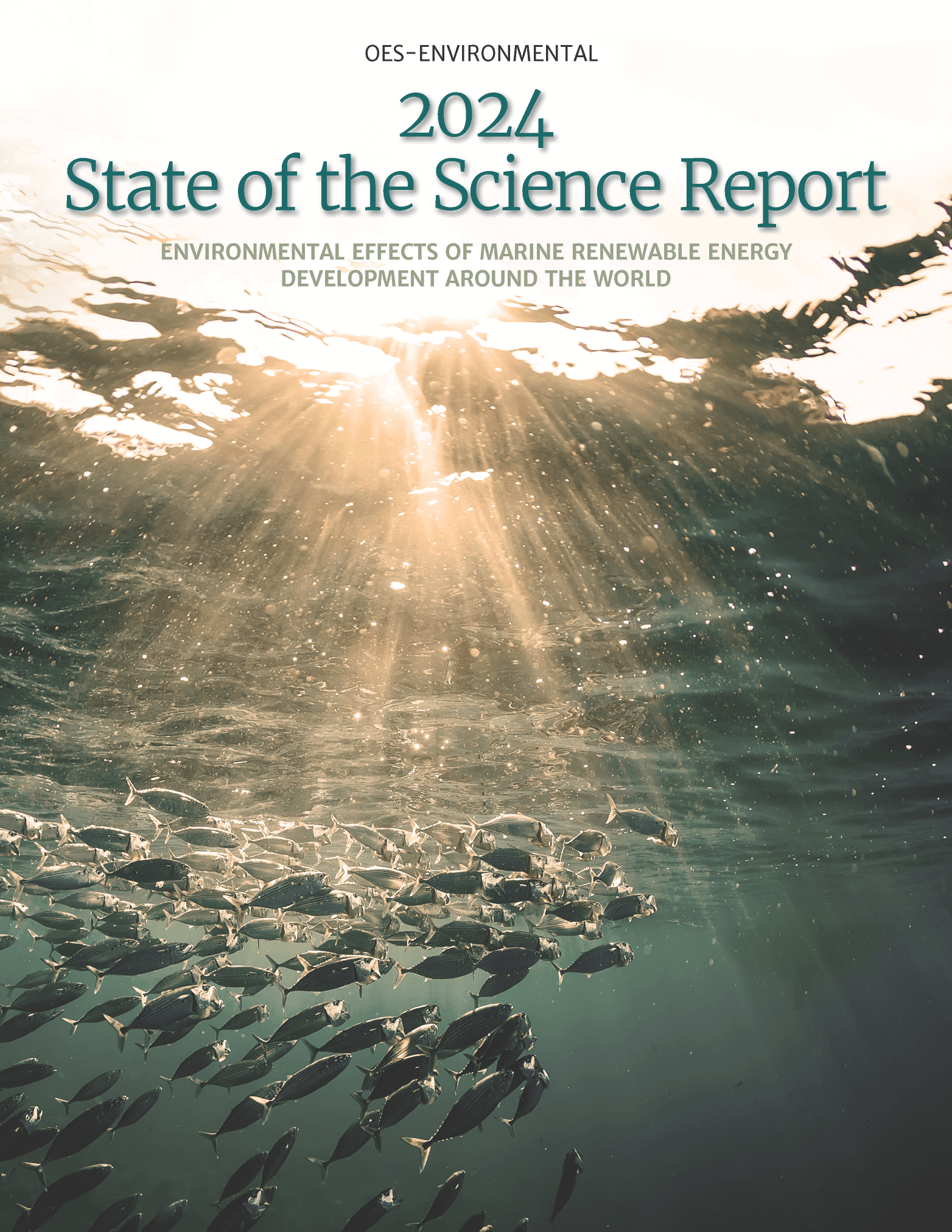

OES-Environmental (Task 4) is led by the U.S. Department of Energy (DOE) and implemented by the Pacific Northwest National Laboratory (PNNL). OES-Environmental is an international collaborative project amongst member countries of the International Energy Agency's Ocean Energy Systems (IEA OES) collaborative. The goal of OES-Environmental is to accelerate the responsible development and operation of marine renewable energy (MRE) technology through the synthesis and dissemination of information and research on the environmental effects of MRE at a global scale. To reach this goal, OES-Environmental member countries collaborate to engage the MRE industry and provide accessible information and data for stakeholders, developers, regulators, and advisors.
Notable OES-Environmental work includes:
OES-Environmental is hosted on Tethys, a knowledge hub which provides access to information, research, and educational resources on the potential environmental effects of wind and MRE development. The different tools developed by OES-Environmental can be found on Tethys: Risk Retirement, Data Discoverability Matrix, Management Measures, Regulatory Frameworks, Socioeconomics Toolkit.
Phase 1: 2010-2013
OES-Environmental (the task formerly known as Annex IV) member countries collaborated to create a searchable, publicly available database of research and monitoring information to evaluate environmental effects. The database, housed in the Tethys Knowledge Base, includes data from MRE projects, research studies and case study reports. Two international scientific workshops were held to provide input for the database and to inform the 2013 Final Annex IV Report.
Phase 2: 2013-2016
OES-Environmental (the task formerly known as Annex IV) was continued for a second phase, continuing the collection, analysis, and dissemination of information on environmental effects of MRE development. During Phase 2, additional emphasis was placed on creating a collaborative space or commons for interaction among researchers, developers, regulators, and stakeholders. Phase 2 culminated with the preparation of the 2016 State of the Science Report, and partnership with the EWTEC 2015 international conference.
Phase 3: 2016-2020
OES-Environmental was approved for a 4-year extension consisting of three interrelated tracks: (1) information gathering and analysis, (2) information dissemination, and (3) engaging the community to support research and monitoring needs. Phase 3 culminated with the completion of the 2020 State of the Science Report.
Phase 4: 2020-2024
OES-Environmental has been approved for Phase 4 and will continue its efforts.
Phase 4 culminated with the completion of the 2024 State of the Science Report.
The tasks performed by OES-Environmental in this phase included:
Phase 5: 2024-2028
OES-Environmental has been approved for Phase 5 and will continue its efforts while increasing emphasis on four key areas: (1) Environmental Acceptability (2) Environmental Effects of Off-Grid Marine Renewable Energy Applications (3) System Wide Effects of Large-Scale Development (4) Social and Economic Effects of Marine Renewable Energy.
Phase 5 will culminate with the creation of the 2028 State of the Science Report.
The tasks performed by OES-Environmental during Phase 5 include:
2024 STATE OF THE SCIENCE REPORT
The OES-Environmental 2024 State of the Science Report: Environmental Effects of Marine Renewable Energy Development Around the World summarizes the state of the science of environmental effects of marine renewable energy (MRE) and serves as an update and a complement to the 2020 State of the Science Report. While the research and monitoring findings prior to 2020 are summarized throughout, the main focus of the report is on the more recent work.
MRE is harvested from ocean waves, tides, and currents, as well as ocean temperature and salinity gradients, and from the flow of large rivers (which use technologies similar to those that capture tidal energy). The 2024 State of the Science report mainly focuses on the potential environmental effects from the generation of power from waves using wave energy converters (WECs), tides using tidal turbines, and large rivers using riverine turbines, but also includes new findings from environmental effects of ocean thermal energy conversion (OTEC) plants. Lessons learned from other offshore industries are included, where appropriate.
This report has brought together the most up-to-date information on potential environmental effects of MRE development, using information from public sources as well as new scientific research. The Ocean Energy Systems (OES)-Environmental country representatives from the 16 participating countries helped to scope the entirety of the report and provided valuable contributions to all chapters. The input from these contributors and reviewers has resulted in the most complete compendium of research and monitoring findings possible.
Download the Full Report and Executive Summary:


Dive deeper into the OES-Environmental work by accessing the Executive Summary available in various languages. Additionally, each individual chapter of the report is available for download, allowing you to explore specific topics in detail.
Start exploring
TETHYS DATABASE
Tethys is a database and knowledge management system which hosts OES-Environmental and provides access to information and research about the potential environmental effects of offshore wind and marine renewable energy development.
f you would like to contribute by submitting a project site or research study metadata form, please visit here.
TETHYS STORIES
Tethys Stories feature information on news, events, research, and projects relevant to wind and marine renewable energy development activities across the globe. Stories are contributed from individuals working in the field, and provide insight into advancing the energy industry in an environmentally responsible manner.
CONFERENCES, WORKSHOPS AND WEBINARS
Dissemination of information is presented at various conferences and workshops.
Here you can assess the list of past conferences and workshops
Tethys also hosts regular webinars as a means to effectively disseminate new information and research efforts to a large international audience of stakeholders. Anyone is welcome to attend these live webinars and participate in a live question and answer session with the presenters.
You can assess the webinar archive here
You can sign up to receive invitations to new live webinars here
Updated December 12th 2024